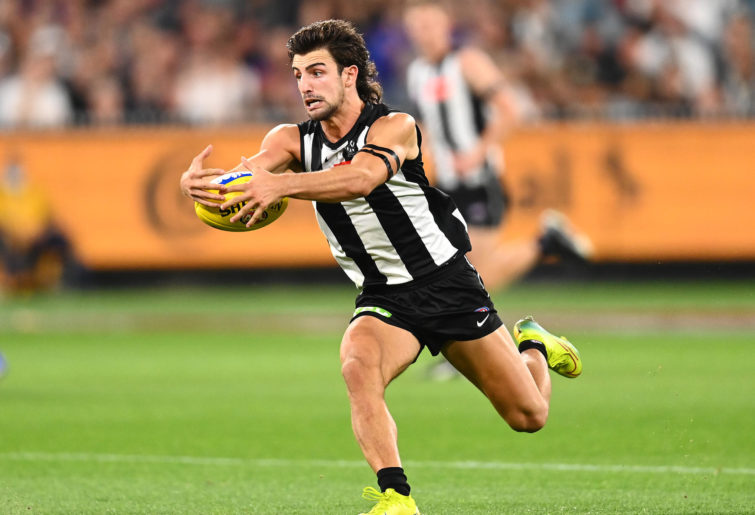Last night, the AFL selected the 2022 All-Australian team and there was some controversy surrounding some of the selections.
There were a dozen debutants in this team, and while this demonstrates that the game is moving into a new and exciting era, the structure of the All-Australian team is sending the credibility of the honour further into disrepute.
To the disgust of the AFL community, the Brownlow Medal has infamously been known for becoming a ‘midfielders medal’, with the last non-midfielder taking out the award three decades ago.
The calls to change the way the medal is voted on and recognised were significant after the 2021 count, and it seems destined to be like that again after next month’s count. This outrage should be headlined over the likely snubbing of Cats forward Jeremy Cameron throughout the count.
Cameron has revolutionised his game throughout 2022, and is without a doubt the best forward in the game. With his ability to place on the podium for the Coleman Medal, in tandem with his centre bounce work, the All-Australian centre half forward should be within reaching distance of the medal (I had him finishing fifth, but knowing how the Brownlow works, that is very unlikely).

(Photo by Daniel Pockett/Getty Images)
However, the midfield bias is set to reign supreme once again, diminishing the remaining credibility of being the AFL’s most prestigious award.
The All-Australian team looks to be heading in the same direction. Yes, it recognises the best players across every line, but it remains evident that the midfield bias is plaguing any form of credibility.
Every year there should be at most five inside midfielders selected in the side (it’s obviously not a clear-cut rule, but it enables balance within the team), and with the competition for inside midfield spots ever so high, this can be quite challenging.
How do the All-Australian selectors respond, you might ask? Select them all and if they don’t fit, shove them into other spots around the ground. It’s acceptable when players have spent the majority of the season in that position, but when they might pinch hit in a certain position, or not even play in the position at all, it demoralises the side.
The latest edition of the side had eight inside midfielders in the team, slightly down from 10 in each of the last two seasons. The last time there was a maximum of five players in the starting 22 was in 2008. So, where exactly are these extra inside midfielders being added?
Apart from the bench (which is usually full of midfielders), these on-ballers are predominantly being placed on the wing. This move has been evident in the All-Australian team for decades, with the side only featuring two starting wingers once in the last 20 years (2018).
2022 saw an abundance of wingman produce stellar seasons. The Melbourne pairing of Ed Langdon and Angus Brayshaw put together arguably the greatest season ever from a wingmen duo. Langdon confirmed himself as a premier winger, while Brayshaw added another string to his bow, peeling off, and playing as a spare man in defence.
Jordan Dawson had an amazing opening campaign for his new club. The Crows star had a career-best season, thanks to his efficient ball use. And who could forget the season that Josh Daicos crafted?
The Pies winger has been the main contributor to a Collingwood side that has notably worked well as a collective.

(Photo by Quinn Rooney/Getty Images)
And who were the wingers selected in the team this year? Touk Miller and Callum Mills. Miller spent 81 per cent of his time in the midfield.
Despite Mills spending more time on the wing than Miller, there were more deserving wingmen to pick from this season. Both players should have been given spots on the bench, if the selectors believed that they should have been in the team. Instead, the selectors picking two on-ballers as wingers was a cop-out.
The half-forward flank is another position where selectors have made cheap calls. The archetype of the impact midfielder floating forward every once in a while has been exploited on so many occasions. The last time there were two genuine half forwards were selected at half forward in the All-Australian team was in 2017.
Since then, it has been used for players such as Marcus Bontempelli, Christian Petracca and Patrick Dangerfield, who have struggled to kick 30 goals in a season, but manage to get in because of their ability to play forward when needed.
Fourteen small forwards kicked 30 goals this season, yet only three of them made the final cut. Two of those were half forwards, whilst Petracca starting as one half forward. Kicking 19 goals for the season, Petracca’s selection in this position proves that the selection committee had nowhere else to put him.
Like the winger situation, if the selectors saw the need to have Petracca in the side, then they should make room on the bench for him, without filling up all four spots with midfielders.
If the midfielder bias is not removed from the game, then accolades such as the All-Australian team are going to be a farce. In all fairness, the defence that was selected was solid, providing good balance. However, it is the other positions on the ground which are tarnishing the reputation of this supposedly prestigious honour.
Players should be rewarded for their efforts based on the positions they play. If they fail to get selected on that basis, they should strive harder to make the team next year, instead of providing this false sense of achievement, at the expense of those who have revolutionised their position.































































































